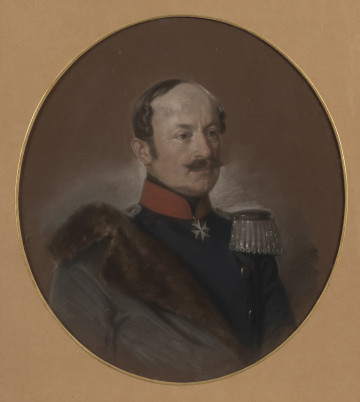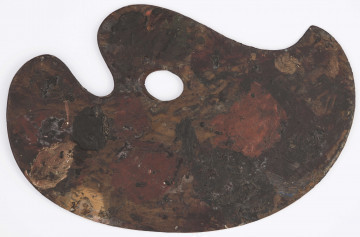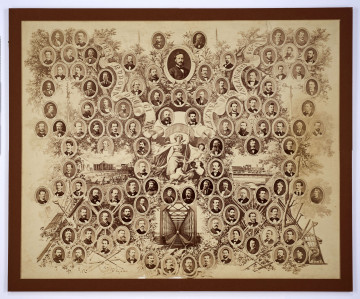
Portrait of Leopold Erhard Rudolf von Puttkamer
1853
National Museum in Szczecin
Part of the collection: European classics of modernity
Jacek Malczewski was known for his canonical works for national identity and as a master of symbolic expression. Among the most frequently used motifs in his paintings were angels, fauns and chimaeras. He often intertwined native folklore and national tradition with characters from mythology and the Bible in the scenes he painted. He is famous for his numerous self-portraits, in which the changes in both his artistic attitude and private life are evident. Autoportret z dwiema postaciami (Autoportret z dziewczyną i faunikiem) [Self-Portrait with Two Figures (Self-Portrait with a Girl and a Faun)] was painted in 1906. It perfectly reflects the specificity of Malczewski's self-portraits. The artist places himself in the centre of the painting, and his image is idealised, almost sculptural. Everything is set in a melancholic atmosphere; the background is the painter's studio in Kraków at the time. The slightly lowered gaze and raised right hand give the impression that the artist has stopped in the moment of the creative act. The faces in the painting are different from each other - the painter's face is illuminated, though at the same time it shows signs of sadness, while the faces of two figures who often appear on his canvases (Maria Balowa, his muse and long-time lover, and the satyr) are covered with a layer of grey. This arrangement creates two planes: the first is the painter concentrating on creation, the second is the world of imagination from which he draws inspiration for his works. Such a composition is a starting point for further dialogue with the viewer. It is worth noting that the faun on the right makes eye contact with the viewer. In this way, we are included in the world inspired by the artist. At the same time, the viewers find themselves in the place of the canvas as if the artist had the power to give shape to the external reality as well. The muse is a reference to one of the most important sources of inspiration for the artist. The butterfly sitting on her hand is both a symbol of beauty and the soul and transience. The faun, in turn, is a symbol of the blind instincts dormant in people. He holds a pinniped in his hand that refers to the Resurrection, the soul, and the Passion of Christ. Thus, we are dealing with a self-portrait of the artist, who engages in a dialogue with the viewer on the essence of creativity and the hardships of experiencing and passing away.
Beata Małgorzata Wolska
Author / creator
Dimensions
cały obiekt: height: 77 cm, width: 96 cm
Object type
painting
Creation time / dating
Creation / finding place
Identification number
Location / status

1853
National Museum in Szczecin

before 1925
National Museum in Lublin

1876
National Museum in Lublin
DISCOVER this TOPIC
National Museum in Szczecin
DISCOVER this PATH
Educational path